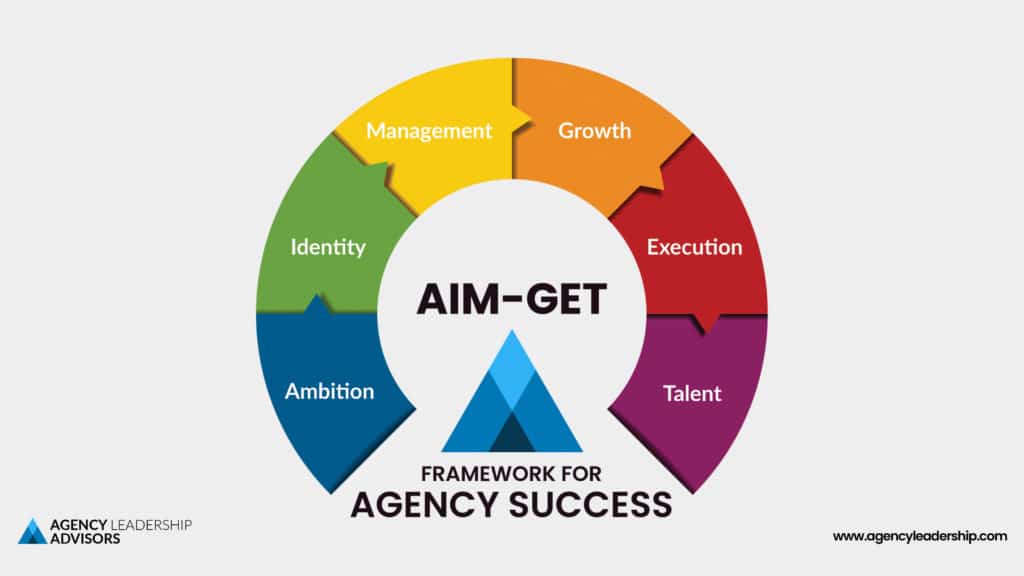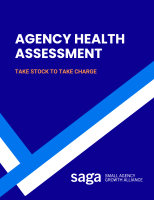No one-size-fits-all solution exists to build a successful PR or marketing agency, but the AIM-GET Framework created by the Small Agency Growth Alliance gives you the guidance you need to make your business deliver the results you want.
Many agency owners never set out to build a business, instead being pleasantly surprised when a freelance business grew beyond expectations. Others did have the entrepreneurial bug and started out with at least a vague vision of what they wanted to achieve.
Regardless of whether you’re a natural entrepreneur or an accidental agency owner, the AIM-GET Framework will help you think through key decisions to ensure that you achieve success — however you personally define it.
The beauty of the AIM-GET Framework is that it works whether you are just getting started or you have had an agency for a decade or more. It guides you as you move from having an inertia-driven business to establishing an Intentional Agency.
The Framework relies on six key pillars to achieve the results you want:
- Ambition
- Identity
- Management
- Growth
- Execution
- Talent
It’s not an entirely linear process since each pillar builds upon and complements each other, but there is a logic to the order that can be helpful when conducting planning and assessment activities.
The AIM-GET Framework isn’t a one-and-done process, but rather a toolset to use throughout the life of your agency business.
It guides strategic planning and goal-setting, drives reporting and measurement, and assists in operational decision-making.
Let’s look at each of the pillars of the AIM-GET Framework.
Ambition
What do you want to achieve with your agency? As the owner, you need to make sure that the business works for you — and not the other way around.
The only way that will happen is if you clearly define your own desires.
Knowing where you want to go will help inform how you get there.
Understanding your personal motivations better will improve your decision-making by providing a useful frame of reference.
Where do you want to be in 5 to 10 years? Not just with your business, but personally? How can your agency business help you achieve that?
Defining your ambition requires being really honest with yourself. Individuals may be attracted to the agency world for any number of reasons.
Some want to change the world. Others just want a steady paycheck. There are those who care more about the flexibility to spend time with family or have the opportunity to travel.
The key is not to look at any other agency owner to determine your own ambition, but rather to figure out what you really want.
Too many agency owners do what they think is the logical next step or make decisions because they believe it is what they are “supposed” to do.
Know what you want — and go for it.
BONUS: Download a workbook to help you define your Ambition
Identity
Perhaps the greatest threat to an agency’s success is a lack of focus.
Undifferentiated businesses struggle to survive in any industry, but represents an even more acute risk in the world of PR and marketing where just about anyone can hang out a shingle.
There’s no such thing as a full-service agency that can serve just about anyone. But too many owners describe their businesses in just that way.
Having a well-defined identity isn’t just important for the marketplace, although it certainly helps to close more clients.
A clear focus also improves the bond among teammates, guides resource and investment decisions, and provides guardrails to deter bad decisions.
Crafting an identity for your agency builds upon the Ambition you established to match what you’re good at (and enjoy) with what the marketplace needs.
Identity is as much knowing what you don’t do and who you don’t serve as it is setting out a list of service offerings and target industries.
Know who you are — and share it clearly with internal and external audiences.
BONUS: Download a workbook to help you refine your Identity
Management
Effective agency management isn’t just about an org chart and a leadership philosophy.
It’s about creating the right structure for the business to help it achieve the Ambition and Identity you defined.
Management comes to the agency business in layers. It starts with whether there will be a single owner or multiple partners. This and other factors define the corporate structure (in consultation with a lawyer and accountant).
But there are myriad other decisions that come into play.
Are you building an office-based business or a virtual agency? Will you fulfill client needs through in-house employees or a network of freelancers?
What third-party partners do you work with to expand your capabilities?
Importantly, this is where you need to clearly define your own role within the business. What are you best at and what do you enjoy doing? How will your management structure fill in the gaps in your abilities or desires?
Getting the Management part right is the key to setting the foundation in the AIM part of the AIM-GET Framework.
Growth
With the foundational pillars established, it’s time to move on to Growth.
No agency — no business — will last long without revenue. Even if your Ambition is to maintain your agency at its current size, you need to have a plan for developing new business to replace clients who churn (and most leave eventually).
Like most of the pillars, the Growth portion of the AIM-GET Framework is both strategic and tactical.
The business development plan needs to account for all of the decisions taken in the AIM portion of the process.
Ambition helps define the revenue targets that need to be met. If you want to retire in 10 years, what does your agency growth need to look like to achieve that objective?
Identity provides guidance about what is being sold — and to whom. Knowing your market and your services keeps things within a manageable scope.
You also need to know who to say “no” to.
Management drives the who and how of the sales process. Are you building it yourself or is that someone else on your team?
Perhaps no other pillar has as much impact on the success in achieving an Intentional Agency.
As a consulting-oriented business, agencies become seen as a sum of their clients, so making the right choices to achieve Growth is absolutely critical.
Execution
Growth very explicitly comes before Execution in the AIM-GET Framework. It’s not merely because it makes the acronym more readable (after all, “AIM-EGT” doesn’t exactly roll off the tongue).
The reason Execution comes after Growth is because you can come up with all sorts of processes and plans for how to service your clients, but until the business actually comes through the door it is nothing but theory.
It is often said that battle plans don’t survive first contact with the enemy. The same can be said of most client service delivery models.
You should have a good idea from the get-go about how you want to achieve results for clients, but the actual processes must always be a work in progress that learns from real-world experience.
That said, the Execution pillar is the primary driver of your profitability.
Done right, good Execution makes you more efficient by establishing repeatable processes that work the first time for clients.
Done right, good Execution helps you accurately track and project costs — meaning you get pricing right as part of the Growth pillar.
Done right, good Execution delivers the results your clients need.
Just as Identity is the lynchpin of the AIM (or planning) portion of the Framework, Execution is the lynchpin of the GET (or operational) section.
Talent
If every agency says that “we are our people” or “we are a people business” or “it’s all about our team” (and just about every agency does), then why is it listed last?
Simple. It’s because all of the preceding elements of the AIM-GET Framework help you to define who the right talent is and how to get them on board with your vision.
An agency is not a talent-driven business. Or, at least, it shouldn’t be.
As noted at the Ambition phase, the agency owner needs to drive the business.
That’s not to say good talent doesn’t make a big difference. In fact, it does.
But the talent must fit within the broader agency master plan. It should meet the identified needs and deliver the right skills and experience to the tasks at hand.
Having all of the other elements in place increases the odds that the right talent will fill the right seats on the bus.
And this will change over time as the agency evolves.
The talent itself can even be involved in encouraging that evolution by bringing new skills and experience and ideas to the table.
The agency owner must foster this environment by investing in the talent, not just through direct compensation, but through an atmosphere that encourages teamwork and collaboration and with the addition of appropriate training and resources.
Putting it All Together
The AIM-GET Framework will help any PR or marketing agency owner build a better business.
It provides the pillars needed to create an Intentional Agency — even for accidental agency owners.
By observing the foundational planning steps (AIM) and applying them to the operational fundamentals (GET), the agency owner can achieve the results they want and make the business work for them instead of the other way around.










